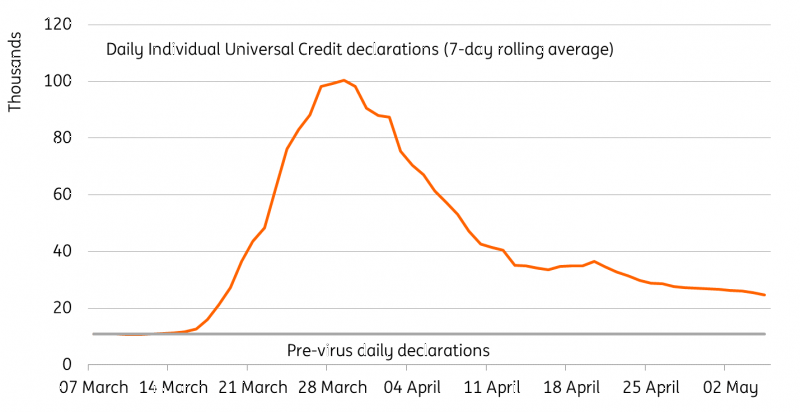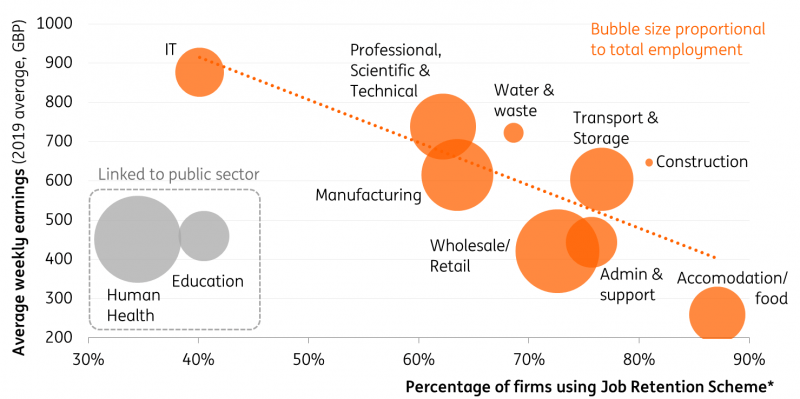UK unemployment has spiked, although so far the government's Job Retention Scheme has helped avert the levels of joblessness witnessed in the United States. However social distancing constraints mean there's a risk unemployment begins to rise again later in the year.
The latest data shows the UK's official jobless rate stayed below 4% in the first three months of the year, but this masks a sharp rise in unemployment over the past few weeks.
Each day, over 100,000 individuals were making declarations for Universal Credit (unemployment support) at the end of March, compared to around 10,000 on an average pre-virus day. According to the initial data for April, that has already helped push the claimant count measure of unemployment to 5.8% from 3.5%, and this will probably rise.
While claims data is not a perfect guide to unemployment, the over two million cumulative declarations we’ve seen over the past few weeks potentially points to an unemployment rate as high as 9%, which if it materialised, would be above the worst we saw following the financial crisis.
Daily Universal Credit declarations
Source: Department for Work and Pensions, ING
Whichever way you look at it, these are undoubtedly shocking figures. But they are also in stark contrast to those in the US, where the unemployment rate looks set to reach 22% in May. This is undoubtedly down to the UK government’s Job Retention (furlough) Scheme, which at the latest count is now paying the wages of 7.5 million workers, or around a quarter of total employees.
There’s little doubt that this scheme should help foster a smoother recovery. Using firms’ payroll is logistically one of the most efficient and quickest ways of channelling support to workers, while it also helps firms avoid the costly and time-consuming process of rehiring as the economy gradually reopens. The scheme will be adjusted over coming weeks to support firms bringing back staff on a part-time basis.
Recent claims and furlough data compared to historical unemployment
Source: Macrobond, Department for Work and Pensions
Universal Credit claims based on cumulative declarations from mid-March. Benefit claims are not necessarily an accurate representation of unemployment
But while the scheme is widely accepted to have been successful so far, it’s biggest challenge may still lie ahead. Covid-19 looks set to change the landscape for many businesses for the foreseeable future, with social distancing here to stay until a widely available vaccine arrives.
Many firms will be unable to operate at full capacity for some time, and this means there's an increasing risk that businesses begin to make longer-lasting changes to their business models. That, in turn, raises the risk of a second wave of redundancies depending on how and when the Job Retention Scheme is eventually phased out.
The risks are particularly acute for the likes of hospitality and retail. We know from recent ONS surveys that these sectors have the highest proportion of firms accessing the furlough scheme. These are also among the industries likely to be most affected by social distancing rules over coming months, and importantly they are also the sectors that have typically led the recovery in the jobs market in previous downturns.
Sectors with the highest usage of the furlough scheme also have lower levels of average pay - which again highlights that those at the lower end of the income scale are likely to be hardest hit.
Higher rates of furlough in lower paid sectors
Source: ONS
*Percentage of employers that are accessing Job Retention Scheme based on ONS Business Impact of Covid-19 Survey. Bubble size proportional to employment by sector. Weekly earnings in wholesale/retail an employee-weighted average of the two sectors.
Read the original analysis: UK: Further challenges lie ahead for stricken jobs market
Content disclaimer: This publication has been prepared by ING solely for information purposes irrespective of a particular user's means, financial situation or investment objectives. The information does not constitute investment recommendation, and nor is it investment, legal or tax advice or an offer or solicitation to purchase or sell any financial instrument. Read more here: https://think.ing.com/content-disclaimer/
Recommended Content
Editors’ Picks
EUR/USD fluctuates in daily range above 1.0600

EUR/USD struggles to gather directional momentum and continues to fluctuate above 1.0600 on Tuesday. The modest improvement seen in risk mood limits the US Dollar's gains as investors await Fed Chairman Jerome Powell's speech.
GBP/USD stabilizes near 1.2450 ahead of Powell speech

GBP/USD holds steady at around 1.2450 after recovering from the multi-month low it touched near 1.2400 in the European morning. The USD struggles to gather strength after disappointing housing data. Market focus shifts to Fed Chairman Powell's appearance.
Gold aiming to re-conquer the $2,400 level

Gold stages a correction on Tuesday and fluctuates in negative territory near $2,370 following Monday's upsurge. The benchmark 10-year US Treasury bond yield continues to push higher above 4.6% and makes it difficult for XAU/USD to gain traction.
XRP struggles below $0.50 resistance as SEC vs. Ripple lawsuit likely to enter final pretrial conference

XRP is struggling with resistance at $0.50 as Ripple and the US Securities and Exchange Commission (SEC) are gearing up for the final pretrial conference on Tuesday at a New York court.
US outperformance continues

The economic divergence between the US and the rest of the world has become increasingly pronounced. The latest US inflation prints highlight that underlying inflation pressures seemingly remain stickier than in most other parts of the world.

